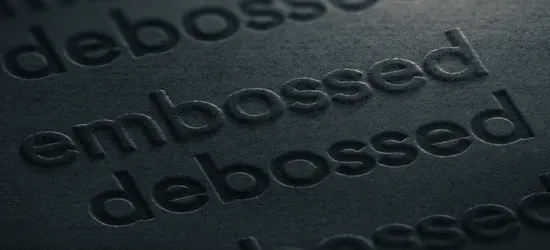
Texture Talks: Embossing vs. Debossing for Your Print Collateral
In the dynamic world of print marketing, mere seconds of attention can increase recall, raise brand awareness, and inspire purchase intent—and including sensory experiences through texture can dramatically enhance the consumer's attention and engagement with a brand. According to A Communicator’s Guide to the Neuroscience of Touch, more than half the brain is devoted to processing sensory experience and much of that sensory receptivity focuses on touch.
There’s marked strength in combining both visual and tactile senses toward gaining consumer attention and creating memorable connection. Enter embossing and debossing, two popular techniques that evoke a reaction and elevate your print materials with textile impressions.
Both methods involve creating raised or recessed relief images and designs in paper and print collateral, but they do so in distinct ways that can impact the perception of your brand. Discover the details of embossing and debossing in order to select the best method for conveying your message with impact.
Embossing and Debossing
Embossing is to raise artwork, or to “carve, mold, or stamp a design on (a surface or object) so that it stands out in relief” as defined by Oxford Language Dictionary. The technique of embossing involves creating a raised pattern on the material surface, and is achieved by pressing a sheet of paper between an embossing plate and a matching counter-plate.
An embossing plate, known as a die, is pressed into the product underneath, raising the profile of the product design, such as a logo, to stand out. Embossing not only adds a tactile element but also introduces a shadow effect, giving depth to the printed material, making it stand out.
Debossing on the other hand, or to “stamp (a design) into the surface of an object so that it is indented”, includes pressing the material downward through a metal die, creating a depressed or sunken effect.
The debossing process is similar to that of embossing, but rather than pressing the die underneath the product to make it stand out, debossing applies the design downward from the top. This indents the design into the product. Debossing offers a subtle yet sophisticated touch that can make design elements feel ingrained in the material, offering a unique sensory experience.
Visual Appeal and Branding
While embossing results in a design that's raised up from the surrounding material, and debossing results in a design that's stamped down or recessed into the surrounding material, both techniques can significantly enhance the visual and tactile appeal of your print collateral. Embossing and debossing offer ways to make your packaging and print materials more distinctive and memorable.
Embossing is particularly popular for logos, titles, or other focal points of your design. It draws the eye and encourages the hand to touch and feel, increasing the interaction with the product. This not only helps in making the brand more memorable but also enhances the perceived value of the product.
Debossing works well for creating a sophisticated, understated look. It is particularly effective for luxury brands or products that want to convey elegance and exclusivity. By pressing the design into the material, debossing creates a discreet visual appeal that invites closer inspection and prolonged contact, which can strengthen consumer attachment to your brand.
Applications and Considerations
When deciding between embossing and debossing, it’s important to consider the purpose of your print collateral and the practical applications of each technique. For example, embossing is generally more popular for greeting cards, business cards, and other types of stationery where the goal is to make the text or logo pop.
Debossing, however, may be preferable for high-end brochures or book covers, where a subtle depth is required without overshadowing the design. Ultimately, both embossing and debossing bring design elements to life and enhance visual and tactile senses in a multitude of print collateral items from postcards and direct mail to brochures, flyers, catalogs, and more.
Sustainability and Cost
Sustainability and the environmental footprint of projects is a crucial factor in today's business decisions. Both embossing and debossing can be done using eco-friendly materials and processes; however, processes that require less heat and pressure during manufacturing can reduce energy consumption, making debossing a slightly more sustainable choice.
Cost is another important consideration. Generally, both techniques require similar investments in equipment and setup, especially for custom designs. However, the run size and material type can influence the final cost. For small runs, debossing might be less expensive as it can be easier to set up for thinner papers; however, the costs can vary widely based on the complexity of the design and the material used.
Selecting Embossing or Debossing
Choosing between embossing and debossing for your print collateral should be guided by the brand image you wish to project, the tactile experience you want to offer, and the practical aspects of your marketing campaign. Both techniques provide a way to make your materials more engaging and memorable.
By understanding the effects of each method, you can better harness the power of tactile printing and texture to enhance your brand's visibility and appeal, ensuring that your message not only stands out visually but is also felt in the hands of your audience.
By: Jen W. O’Deay
To talk further about including embossing or debossing for your next print project, Millcraft is here to answer any questions you may have, Just ask.
Sources:
https://fsea.com/wp-content/uploads/FSEA_WhitePaper_CoffeeStudy.pdf
https://sappipops.com/wp-content/uploads/2020/07/sappi_neuroscience_of_touch.pdf
https://refinepackaging.com/blog/embossing-vs-debossing/ https://www.packagingimpressions.com/article/connecting-with-consumers-via-digital-embellishments/